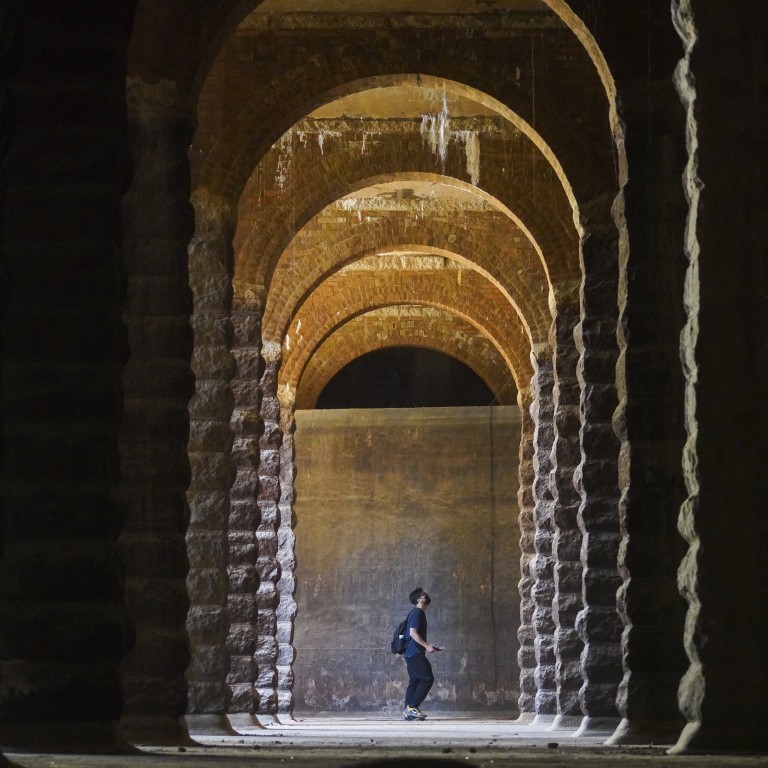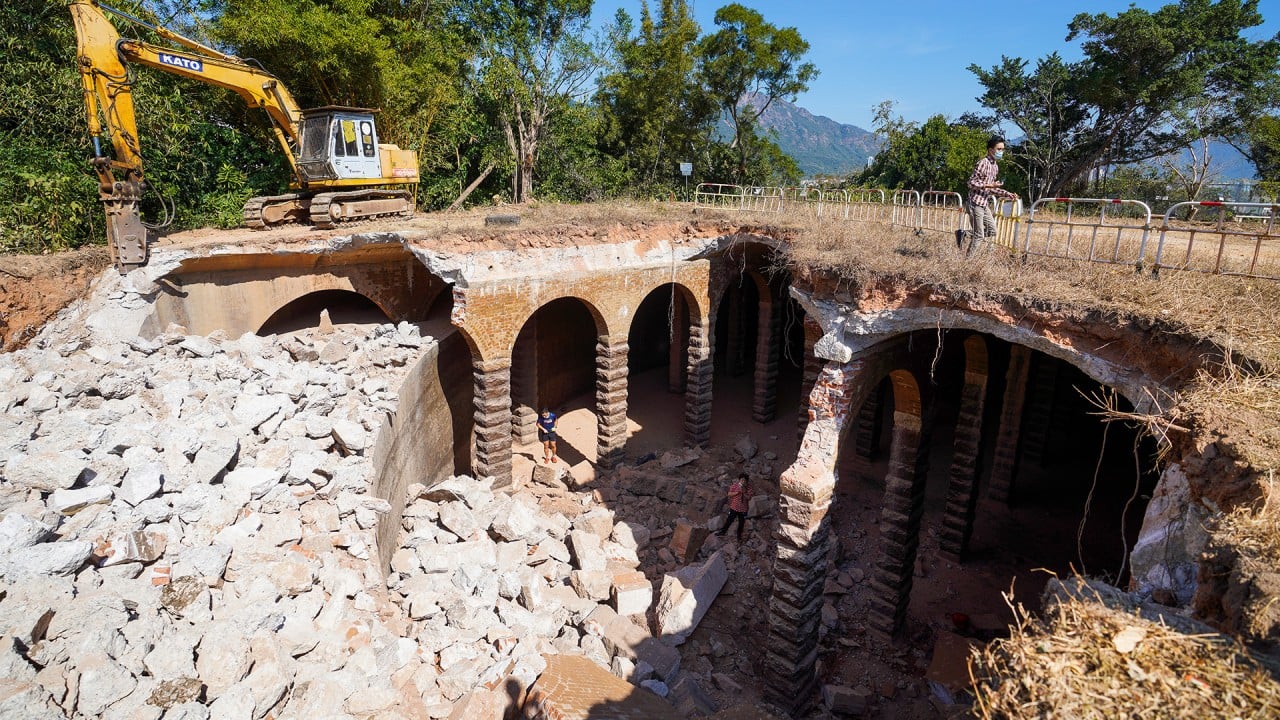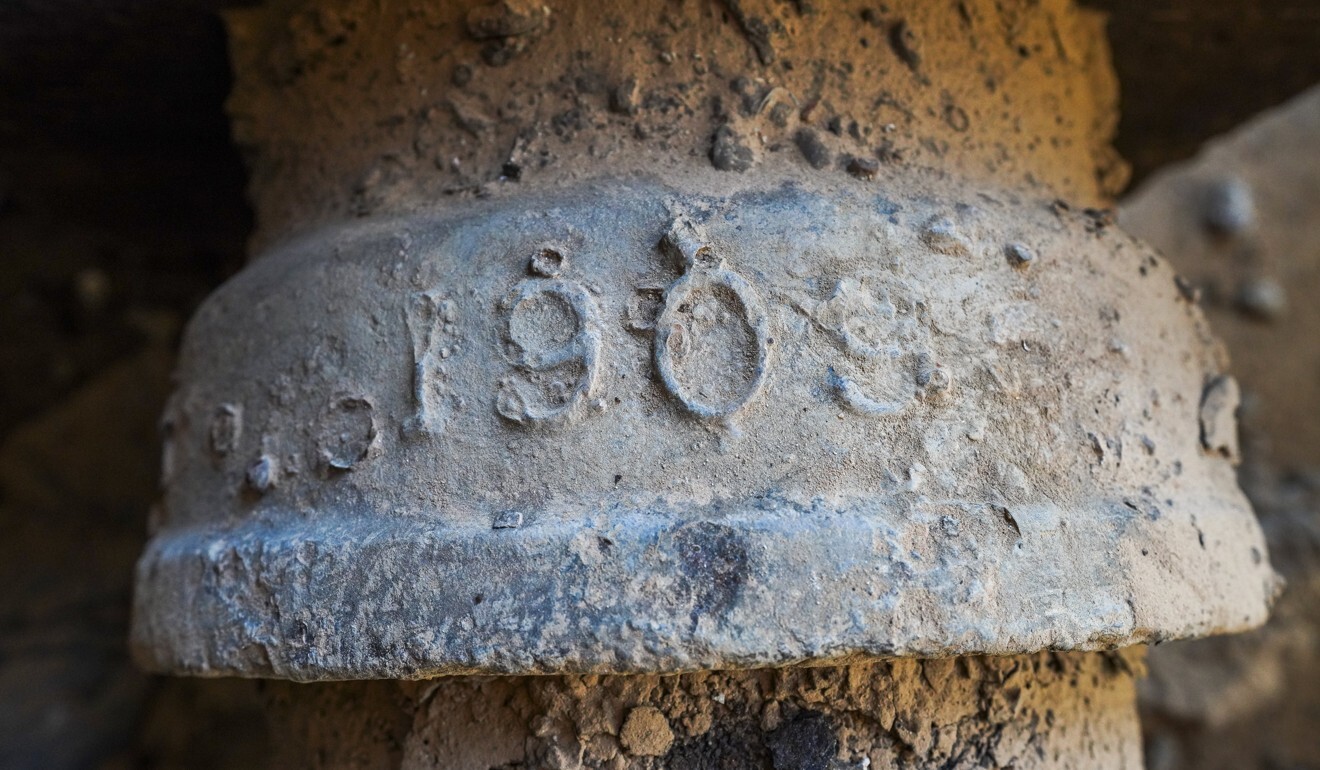
Demolition of century-old underground reservoir suspended by Hong Kong authorities after they bow to public calls for it to be preserved
- The underground reservoir, believed to have been completed in 1904, is a cavernous chamber featuring soaring brick arches
- It first came to the public’s – and heritage advisers’ – attention on Monday after images taken by locals went viral
Demolition work has been halted after conservationists, politicians and heritage-minded members of the public appealed for the preservation of a massive, arched-brick, underground reservoir in Hong Kong dating back to the beginning of the last century.
The service reservoir in an area known locally as Bishop Hill in Shek Kip Mei, Sham Shui Po, discovered underground as the Water Supplies Department was clearing the site to hand it over to the Lands Department, had apparently escaped the attention of government heritage advisers.
The striking-looking, cavernous structure was slated to be dismantled without publicity, but images shared online by members of the public and picked up by the news media tapped into a groundswell of heritage-protection sentiment and put pressure on government bureaucracy to preserve it.
A visit by the Post found that demolition works had already started, with the site mostly closed off by metal fences. The underground chamber can be accessed by climbing down several ladders from an opening in the ground, believed to be used by construction workers.

01:19
Demolition of Hong Kong old reservoir halted after calls for heritage assessment
The site was partly ruined, with chunks of broken bricks and rubble filling up one portion, fragments of the high ceilings chipped off and plant roots poking through from above.
But about 30 arches, each about six metres tall, were still intact, with some 50 curious hikers and photographers exploring the area and posing for photographs on Monday, despite warnings from workers that the site was not safe.
A man in his 70s surnamed Lee was one of the residents who had seen the reservoir being torn down.
“The water reservoir is beautiful, like a maze, but we won’t be able to see it again,” he said on Monday, while adding it was “not for us to say whether it’s right” to demolish it.
In pictures: explore the century-old underground reservoir unearthed on Bishop Hill
According to a report from the director of public works issued in 1905, construction of a service reservoir on a hill to the north of Kowloon Tong was completed on August 10 the year before.
It was built after an existing one in Kowloon was found inadequate to serve the area during a breakdown, according to another government document from 1900. The number “1909” was also found on a metal pipe at the site.
Yeung Yuk, chairman of the Sham Shui Po district council, said the body was not made aware of the structures when Water Supplies Department officials briefed them on the project in May, adding that he had been among those who had asked the government to halt the demolition work.

“I didn’t know it’s so beautiful underneath,” Yeung said. “It’s at the hilltop, covered by a flat surface with grass and mud, and it has been fenced off.”
Yeung said the council was only told that the service reservoir was no longer used and the site would be handed over to the Lands Department to decide on a new use for it.
According to the paper submitted to the council in May, the reservoir is located on a 4,300-square-metre (46,000-square-foot) site on the hill. The tank is 47 metres (154 feet) in diameter and seven metres (23 feet) deep, and had been in disuse. The demolition work would be followed by backfilling the underground space and slope stabilisation before the site was developed.
The Water Supplies Department and the Antiquities and Monuments Office (AMO), both under the Development Bureau, confirmed in a joint reply to the Post that the demolition had been suspended.
“The AMO has sent staff today to take a preliminary inspection and will conduct an assessment according to the established mechanism, in order to explore the way forward,” the reply read.

It did not, however, address the Post’s initial question as to why the site was not included in the grading exercise in the first place.
From 1996 to 2000, the antiquities office conducted a territory-wide survey on the buildings in Hong Kong built before 1950. Some 8,800 buildings were recorded, and 1,444 of them, considered of higher value, were selected for a more in-depth survey in 2009.
The service reservoir site was not on the list of 1,444. Reservoir structures on Hong Kong Island, however, were graded, with some granted monument status for permanent preservation.
Hong Kong’s first ‘barrier-free’ waterfront opens in Wan Chai
A person familiar with the grading exercise who spoke on condition of anonymity said it was likely the Kowloon site could have been missed from the very beginning.
“The AMO invited local and mainland scholars to do the stocktaking by way of site visits to different parts of the city. Government departments were not asked to give input,” they said.
“It was never a ‘seamless’ search, and there were also items that were later discovered by the public and added to the list.”

Paul Chu Hoi-shan, an architect and member of the Antiquities Advisory Board, which advises the government on heritage conservation matters, said that such reservoir tanks “do not normally fall into the assessment list”.
“It’s a positive thing that people are very much … concerned with antiquities and monuments in our city,” he said, adding it would be “positive” to halt the demolition and let the monuments authority examine the structure.
Chu, however, urged the public not to go into the site for safety reasons.
Andrew Lam Siu-lo, a former Antiquities Advisory Board chairman, said the board mostly graded structures above ground. “When we talk about the grading … we can see these buildings above ground,” he said. “But what’s below ground, we don’t see.”
Local historian Ko Tim-keung said this was his first time he had heard of the site, and criticised the government for starting demolition without conducting surveys or research.
“I’ve never come across such a site in Hong Kong; it is quite meaningful,” he said. “It should have been a historical and cultural relic for Kowloon’s development.”


